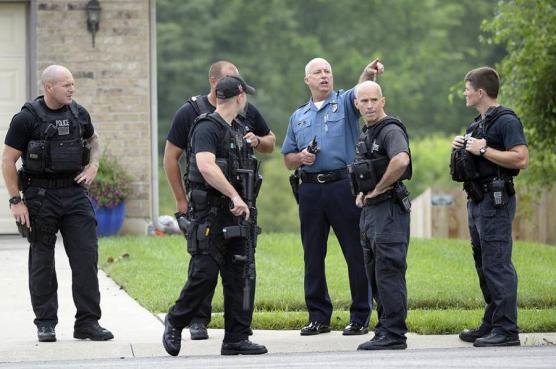To Mayor Sly James and Chief of Police Darryl Forté:
I am about to make a radical suggestion, an idea that runs counter to prevailing thought on justified police actions: that every civilian, even those that open fire on police officers or innocent bystanders, deserves to live.
That it is right and just that all Kansas Citians, not matter how deranged or violent, deserve to see their constitutionally-guaranteed day in court.
It may seem a strange idea to those conditioned to assume anyone who fires a gun at others has automatically given up his or her right to life, even if said person suffers from mental illness. Here I suggest a higher form of ethical thinking.
In light of yesterday’s condemnatory report in The Kansas City Star that found 47 Kansas Citians died in altercations with police from 2005 to 2014 (with 56 more wounded by police gunfire), a rate higher than many similarly sized cities, it is time to reconsider how Kansas City arms its officers.
This is especially true when considering “about half the confrontations involved someone suffering from mental illness or depression or someone suspected of being impaired by drugs or alcohol.”
The accompanying analysis of the incidents in The Star found that “in at least four cases, officers first tried nonlethal force, such as a stun gun, a rubber bullet or a bean bag.” One man was shot by a rubber bullet in 2013, “but it didn’t work.” A woman in 2007 was struck by a beanbag round to “no effect.”
So in four cases out of 103, or 3.8%, police tried nonlethal force first. That, to any person who values life, is unacceptable.
Chief Forté insists, “If you look at the people we shot…they dictated how we responded to them.” That is without question mostly truthful, but ignores a reform that could have saved dozens of lives in Kansas City (thousands across the U.S.).
The Kansas City Police Department should be armed only with rubber bullets.
True, rubber bullets will sometimes fail to take down a criminal on the first shot (though the same complaint can be made of standard bullets). And critics will protest, calling it foolhardy to give a criminal with standard bullets an edge over an officer with rubber ones.
Yet Kansas City police officer deaths due to gunfire are extraordinarily rare. In the same period that 47 civilians died in confrontations with the police, no KCPD officers died in the line of duty, according to the Officer Down Memorial. Since 1990, 6 officers have died in the line of duty, all due to vehicle accidents.
The last officer to die from gunfire was in 1983. In total, 67 Kansas City policemen died from intentional gunfire since 1879 (averaging 0.49 a year). In contrast, from 2005 to 2014, the police killed 35 people who had a gun or were suspected of having a gun (3.5 per year).
When the scope of data is broadened to include officer deaths by intentional gunfire, assault, vehicle pursuit, and vehicular assault, 77 perished (0.56 per year) since 1879. Compare this to the 47 civilians killed by police from 2005-2014 (4.7 per year).
All this is not to devalue the lives of police officers, who deserve much admiration for their courage and sacrifice.
It is to suggest that, while acknowledging the possibility of increased risk to police officers, a rubber bullets only policy may save more lives overall (including, perhaps, police officers’: since 1879, 7 officers died from accidental gunfire; while the data does not clarify, it is not beyond the realm of possibility that an officer accidentally shot by a fellow policeman may have a better chance of living were he or she struck by rubber bullet).
This reform should be enacted in the name of all Kansas Citians, but especially the names of those whose deaths were truly senseless, like Ryan Stokes, who allegedly refused to stop running from police and was, at the moment of his death, unarmed, or Javon Hawkins, who refused to put down a sword and was killed.
True, rubber bullets can kill — they are not a perfect solution, and depend very much on who uses them and how, in the same way police can use tasers to kill (a Virginia man in 2013 was tased 20 times and died), nightsticks to kill, or fists to kill (the beating of Manuel Palacio in 2014 by the KCPD could have easily continued longer and resulted in Palacio’s death).
Yet rubber bullets are far less lethal than standard bullets, and can therefore prevent wrongful deaths and afford every suspect his or her right to a fair trial. Reducing police killings is also, without question, the ethical thing to do in light of the statistical analyses and psychological research that indicate, due to both conscious and subconscious anti-black biases, blacks are far more likely to be killed by police than whites who commit identical crimes.
The idea that shooters deserve to be gunned down immediately usually changes if said shooter is your son, brother, sister, or mother. People tend to apply their ethics inconsistently (a practice that must change), believing it right for a stranger (especially of a different race) to be shot to death for his or her actions, but not someone they love in an identical scenario exhibiting the same behavior.
Standard bullets need not be eliminated completely; more dangerous ammunition can be kept on reserve for escalated situations, for instance if it was determined a suspect was wearing a bullet-proof vest.
Kansas City can lead by example, showing America how many lives can be saved if we use the technology available to us.
















